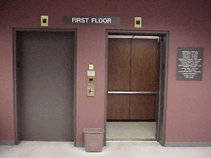
« PREVIOUS ENTRY
Argon gas: A new way to preserve wine
NEXT ENTRY »
Why did we evolve personalities?

A few months ago, I blogged about a neat elevator hack that allows you to commandeer an elevator and go directly to your floor, without waiting for others. Weeks later, Nick Paumgartner at the New Yorker actually wrote an entire column where he attempted to use the hack, and recorded his rather mixed results.
Now Fujitec America Inc. — an elevator company whose tagline is “The Art and Science of Moving People” —has developed a technique that is both more ethical and more mathematically interesting: An algorithm that eases elevator bottlenecks by intelligently grouping passengers based on their destination. It works like this: When you arrive at one of these stylin’ new elevators, you enter your destination floor in a kiosk. Then a message appears telling you which car to get on. As a story in The Enquirer reports:
In time, the new Fujitec system becomes even more efficient at grouping passengers by learning elevator-use patterns, said Rennekamp, whose team of engineers pioneered the software for the system. It does this by considering historical information to learn traffic variances in the building.
“The predictive logic in our software acts like neurons in our body, parking (the elevators) at certain floors, knowing where the demand might be at certain times.”
Here’s the interesting thing: Fujitec claims that when you route passengers into groups of people with similar destinations, two things happen: i) You wind up waiting longer to actually enter the elevator, but ii) the actual trip in the elevator is so fast that it more than recoups the extended wait, making the total trip faster.
This makes me suspect that people will actually dislike the experience — because they’ll focus on part i) too much. As psychologists have long shown, people tend to dislike systems that leave them feeling out of control, even if it’s ultimately better for them. (The converse is also true: People will tolerate situations of great discomfort if they feel they have some control over it, as with studies of people’s reactions to loud noises.) Since part i) of this new algorithms requires people to sit around waiting even longer than they normally would for an elevator, I’d bet users would rebel: Even if system gets them to their destination more quickly, it’ll feel like it’s taking longer, and they’ll hate it.
(Thanks to Boing Boing for this one!)
I'm Clive Thompson, the author of Smarter Than You Think: How Technology is Changing Our Minds for the Better (Penguin Press). You can order the book now at Amazon, Barnes and Noble, Powells, Indiebound, or through your local bookstore! I'm also a contributing writer for the New York Times Magazine and a columnist for Wired magazine. Email is here or ping me via the antiquated form of AOL IM (pomeranian99).

ECHO
Erik Weissengruber
Vespaboy
Terri Senft
Tom Igoe
El Rey Del Art
Morgan Noel
Maura Johnston
Cori Eckert
Heather Gold
Andrew Hearst
Chris Allbritton
Bret Dawson
Michele Tepper
Sharyn November
Gail Jaitin
Barnaby Marshall
Frankly, I'd Rather Not
The Shifted Librarian
Ryan Bigge
Nick Denton
Howard Sherman's Nuggets
Serial Deviant
Ellen McDermott
Jeff Liu
Marc Kelsey
Chris Shieh
Iron Monkey
Diversions
Rob Toole
Donut Rock City
Ross Judson
Idle Words
J-Walk Blog
The Antic Muse
Tribblescape
Little Things
Jeff Heer
Abstract Dynamics
Snark Market
Plastic Bag
Sensory Impact
Incoming Signals
MemeFirst
MemoryCard
Majikthise
Ludonauts
Boing Boing
Slashdot
Atrios
Smart Mobs
Plastic
Ludology.org
The Feature
Gizmodo
game girl
Mindjack
Techdirt Wireless News
Corante Gaming blog
Corante Social Software blog
ECHO
SciTech Daily
Arts and Letters Daily
Textually.org
BlogPulse
Robots.net
Alan Reiter's Wireless Data Weblog
Brad DeLong
Viral Marketing Blog
Gameblogs
Slashdot Games